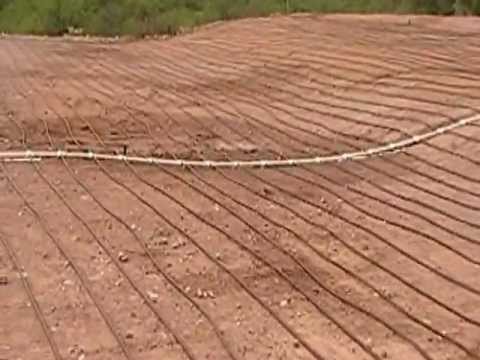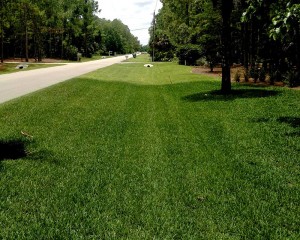May
Water Restrictions and Your Lawn. What Now? PART-2
So here we are, May of 2015, and for the first time in many of our lives we are being asked to cut our water usage by at least 25%. As I alluded to in PART-1 of using water wisely (please click here to read PART-1 if you have not already) many people view water consumption solely as an agricultural problem. It is easy to look at the percentages of water used by the agricultural industry and blame them for the water shortage, but have you considered that the real problem lies within us.
Did you know that over the past ten years the agriculture industry has lowered their water use rate from as much as 90% to less than 69% of total water consumed? Again many of you will look at the percentage of water used and say it is still too high, but the homeowner use rate has skyrocketed, while agriculture has learned to adapt and change.
Did you know the average family of four wastes 10,000 gallons of water a year waiting for hot water to arrive to their shower? Right there you can save 6% of your yearly water use. I know we’re supposed to be talking about landscape water rates, but more needs to be addressed than simply blaming one industry. I will be the first to tell you landscape water use rates need to go down. The average household wastes 16,000 gallons of water per year overwatering their landscapes. This is an additional 9% of your yearly water total being wasted. Today I will be giving you directions on how to not only save the 9% of overwatering, but I will also give you ways to save another 10% by watering smarter and using proper agronomic practices. I would be remised if I didn’t say this before I begin. Grass doesn’t waste water, people do.
I know it is pretty tempting to take the money some cities are offering for removing turf, but have you considered what it will do to your electric bill? The pictures in last week’s blog showed you the temperature differences between asphalt, artificial turf, grass, and bare soil. Removing your lawn and adding desert landscaping can change the outside surface temperature by 27%. By adding artificial turf to your house you could change the outside temperature by 33% or more. This number alone is going to cause your air conditioner bill to significantly increase as your compressor now needs to work that much harder to lower the internal temperature of your home. Would you take out the shade tree in your front yard and replace it with a larger air conditioning unit because it requires water? You have now traded a water problem for an energy problem. I found this fact interesting in doing research for this post.
It takes 25 gallons of water for every kilowatt hour of energy produced. Are we really saving water if we increase the external temperature of our homes by removing our turf? It will take a lot of energy to keep our homes cool if the temperature is 132 degrees around our house. Remember in PART-1 of my blog where I said front lawn of eight homes has the cooling effect in hot weather of about 70 tons of air conditioning? We already know that we can save 15% of our daily water use rate by using an efficient hot water tank and not overwatering your lawn. The question now is do we pass the blame to the power companies or do we control the controllable?
It is time that we learn how to make ourselves more efficient users of water. I won’t harp on all the ways you can save water in your house, but I will tell you all the ways you can have a beautiful lawn and respect the environment at the same time. Turfgrass is not a large consumer of water–inefficient watering systems are large consumers of water.
Last time I discussed setting up a timer clock to your irrigation system. The newest irrigation controllers on the market are now weather based systems and they can reduce overwatering by as much as 85%. A weather based controller adjusts your irrigation cycles to the current weather pattern. How many parks have you driven by during a rainstorm and saw water running? A weather based controller will automatically shut itself down during a rain event and will not go on until a certain percentage of evapotranspiration has occurred. This could be a week after a rain event, whereas a programmed clock will automatically run on the days you set it to unless you remembered to turn it off.If you’re at work or on vacation it’s not very easy to shut down your irrigation system if you’re not in front of the timer. If these clocks can save 85% of wasted water you’ve already cut 13,600 gallons of water per year/per household. Think about the water savings in a large greenbelt or park if they switched to weather based controllers.
We have fielded the calls lately from concerned homeowners about putting in a new lawn. I advise them of the following things when considering a lawn:
1. Use turfgrasses that are adapted to your area. Don’t install cool season grasses in an arid environment during the summer months. A warm season grass only needs water every 12-21 days to stay alive whereas a cool season grass needs water every 5-7 days.
2. Prep the soil correctly before you begin the process. Proper soil pH and a soil void of compaction will help ensure water can be utilized.
3. Install a weather based controller/timer.
4. Research using subsurface irrigation once your lawn is established. It only takes two weeks to establish a lawn.
5. Use proper agronomic practices. Consider letting your lawn go dormant during the off season. There are organic turf paints and colorants now that are so realistic that many golf courses have forgone overseeding during the winter months. Letting your lawn go dormant will save you from watering your lawn for half of the year.
We have already discussed the first three so let’s discuss how to utilize the other two. I want to start with the new technology known as sub terrainial irrigation. A sub terrain irrigation system is a drip irrigation system in which tubing is placed in the turfgrass root zone to water the grass. The drip tube has emitters (small holes) every 8-12 inches that allow droplets of water to flow at reduced rates. Many of you already use a similar system for your plants. The emitters will vary in the amount of water they put out depending on water pressure, spacing, emitter size, etc. The average system applied between 0.25 to 1 gallon of water per hour. I know that doesn’t sound like much water but it is sufficient because of how the efficiently the water is used. A properly installed drip system can produce a 90%+ efficiency rate versus 80% for pop up sprinklers or 65% for flood irrigating.
Why is it so much more efficient?
1. The drip lines are down in the root system so no water is lost to evaporation or runoff.
2. Environmental conditions such as wind don’t impact the amount of water given to the turfgrass plant.
3. Water is applied evenly across the root zone so there are no puddles on the surface or in low areas.
Some of the advantages of using a sub terrain system over a sprinkler system are:
1. They encourage a deep root system by making the grass go get the water.
2. Since there is no ponding on the turf surface you can enter the area during or immediately after the irrigation cycle.
3. Most systems are designed to allow for easy fertilizer applications through the drip lines.
4. With no surface water shallow rooted weeds will be choked out that thrive on wet conditions.
5. There is no set time of the day that the water needs to run since none will be lost to evaporation.
One of the best ways to reduce water usage for current lawns is by using proper agronomic practices. If you’ve had a lawn for more than six months then a thatch layer has already started to build up in your lawn. Thatch is the accumulation of dead roots, shoots, and stems at the soil surface. When thatch builds up it serves as a barrier for water to infiltrate the ground and get down to the roots. A healthy lawn will thrive by having no more than ½” of thatch. In order to control the thatch layer one must set up a yearly schedule that includes aerification and dethatching. I highly suggest that at least once per year you aerify your lawn by pulling ¼” to ¾” cores. These cores can be mowed up and almost immediately you will notice a difference in water availability and reduced runoff.
Other agronomic practices that should be followed:
1. Water early in the morning. Don’t water if it is too windy.
2. Raise the mowing height of your lawn to reduce evaporation.
3. Fix compacted soil by aerifying and adding soil amendments such as gypsum.
4. Let your lawn go dormant and use turf paint such as Endurant. This will give your lawn a dark green look without having to water more than every couple of weeks to keep the grass alive.
5. Use warm season grasses when the option is available.
6. Don’t pick up your lawn clippings.
7. Improve the soil pH with gypsum or lime.
8. Mow more often, not shorter. The shorter you mow the grass the more water it needs to cool the plant. The soil surface dries out faster the shorter the turf stand.
9. Perform frequent irrigation system checks by placing collection pans all over the yard.
10. Finally, only water when it is absolutely necessary. Grass will adapt to so many environmental conditions, and you’re not going to kill it by stretching out the watering until the following morning.
It’s easy to use a broad brush and paint turfgrass as the enemy, but the positive impacts far outweigh the negatives. We can control the amount of water that is used for turfgrass by making sound decisions, researching turfgrass varieties, and being conscious of how to use water properly. Eliminating turfgrass is only creating other problems that we will have to deal with down the road. It’s time everyone comes together and we cut water usage by 25% or more by just being mindful of our daily decisions.
If you have any questions, please go to the “Ask Jay” button to the top right of this page. I will be happy to answer them.
Until next time,
Jay



